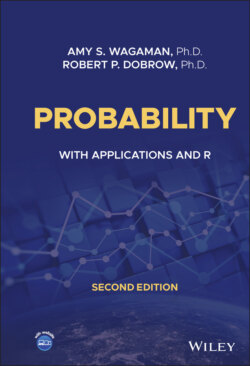Читать книгу Probability - Robert P. Dobrow - Страница 16
1.1 RANDOM EXPERIMENT, SAMPLE SPACE, EVENT
ОглавлениеProbability begins with some activity, process, or experiment whose outcome is uncertain. This can be as simple as throwing dice or as complicated as tomorrow's weather.
Given such a “random experiment,” the set of all possible outcomes is called the sample space. We will use the Greek capital letter (omega) to represent the sample space.
Perhaps the quintessential random experiment is flipping a coin. Suppose a coin is tossed three times. Let H represent heads and T represent tails. The sample space is
consisting of eight outcomes. The Greek lowercase omega will be used to denote these outcomes, the elements of .
An event is a set of outcomes, and as such is a subset of the sample space . Often, we refer to events by assigning them a capital letter near the beginning of the alphabet, such as event . The event of getting all heads in three coin tosses can be written as
Event contains a single outcome, and clearly, . More commonly, events include multiple outcomes. The event of getting at least two tails is
We often desire probabilities of events. But before learning how to find these probabilities, we first learn to identify the sample space and relevant event for a given problem.
Example 1.1 The weather forecast for tomorrow says rain. The number of umbrellas students bring to class can be considered an outcome of a random experiment. If at most each of students brings one umbrella, then the sample space is the set . The event that between 2 and 4 umbrellas are brought to class is
Dice are often used to illustrate probability concepts. Unless stated otherwise, in this text, rolling a die refers to rolling a fair six-sided die with the usual numeric labels of the numbers 1 through 6.
Example 1.2 Roll a pair of dice. Find the sample space and identify the event that the sum of the two dice is equal to 7.The random experiment is rolling two dice. Keeping track of the roll of each die gives the sample spaceThe event is The sample space can also be presented using an array format, where the rows denote the first roll and the columns denote the second roll. The cell entries are the sum of the row and column numbers. All 36 outcomes will be represented in the resulting cells. The event can then be identified by finding the cells that correspond to the desired criteria.
Example 1.3 Yolanda and Zach are running for president of the student association. One thousand students will be voting, and each voter will pick one of the two candidates. We will eventually ask questions like, What is the probability that Yolanda wins the election over Zach by at least 100 votes? But before actually finding this probability, first identify (i) the sample space and (ii) the event that Yolanda beats Zach by at least 100 votes.(i) The outcome of the vote can be denoted as , where is the number of votes for Yolanda, and is the number of votes for Zach. Then the sample space of all voting outcomes is(ii) Let be the event that Yolanda beats Zach by at least 100 votes. The event consists of all outcomes in which , or . That is,
Example 1.4 Diego will continue to flip a coin until heads appears. Identify the sample space and the event that it will take Diego at least three coin flips to get a head.The sample space is the set of all sequences of coin flips with one head preceded by some number of tails. That is,The desired event is . Note that in this case both the sample space and the event are infinite, meaning they contain an infinite number of outcomes.
